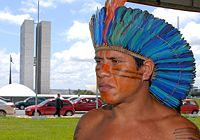Tupi people
 Albert Eckhout's painting of the Tupí | |
| Total population | |
|---|---|
| 1,000,000 (historically), Potiguara 10,837, Tupinambá de Olivença 3,000, Tupiniquim 2,630, others extinct as tribes but blood ancestors to Pardo and Mestizo Brazilian population | |
| Regions with significant populations | |
| Central and Coastal Brazil | |
| Languages | |
| Tupian languages, later língua geral, much later Portuguese | |
| Religion | |
| Indigenous, later Christianity |
The Tupí people were an important ethnic group of indigenous peoples in Brazil. Scholars believe they first settled in the Amazon rainforest. Later, they started to move to the south and settled on the Atlantic coast.[1]
History
[change | change source]The Tupí people were living in almost all of the Brazilian coast when the Portuguese first arrived there. In 1500, their population was estimated to be 1 million people. They were divided into tribes, each tribe numbering from 300 to 2,000 people. Some of these tribes are: Tupiniquim, Tupinambá, Potiguara, Tabajara, Caetés, Temiminó, Tamoios.
The Tupí had agriculture. They grew cassava, corn, sweet potatoes, beans, peanuts, tobacco, squash, cotton and many other crops.
European colonization
[change | change source]After the 16th century, the Tupí were assimilated, made to work as slaves, or killed by diseases such as smallpox[2] or by Portuguese settlers and Bandeirantes (colonial Brazilian scouts). Except for a few communities, nearly all the Tupí were killed. Today, the descendants of the survivors live on Indian reservations or are part of the dominant Brazilian society.[3]
Cannibalism
[change | change source]The Tupí were divided into several tribes which would constantly engage in war with each other. In these wars, the Tupí would try to capture their enemies to later kill and eat them.[3] They believed that they would gain the strength of the warriors they eat. The Tupí also ate the remains of dead relatives.[4]
Cannibalism by the Tupí decreased after European contact and religious intervention. When Cabeza de Vaca, a Spanish conquistador, arrived in Santa Catarina in 1541, for instance, he attempted to ban cannibalism.[5]
Some scholars question whether the Tupí actually engaged in cannibalism. They do not think the sources that talk about cannibalism, mostly written by Europeans, are reliable.[6]
Race-mixing and Cunhadismo
[change | change source]
In the 16th century, the Tupi were the first group to have contact with the Portuguese. The Portuguese colonists did not bring many women, so miscegenation between Portuguese settlers and indigenous women started.[3] The Tupi had a tradition, called Cunhadismo, of incorporating strangers to their community. The Indians offered the Portuguese an Indian girl as wife. Once he agreed, he formed a bond of kinship with all the Indians of the tribe. The settlers also adopted the Indian practice of polygyny.[3]

The relatives of an Indian woman would have to work for her husband. If a settler had many Indian wives, he would have a large number of Indian relatives who would have to work for him. They would mostly have to cut wood and take it to the ships on the coast. Since there were not a lot of Portuguese women in Brazil, intermarriage made it easier for the Portuguese to colonize the country.[3]
Influence in Brazil
[change | change source]Although most of the Tupí population died, a large population with Tupí-Portuguese ancestry occupied much of Brazilian territory. They continued the ancient Tupí traditions in several points of the country. Darcy Ribeiro wrote that the first Brazilians looked more like the Tupí than the Portuguese. The language that they spoke, called Nheengatu or Língua Geral, was based on Tupí.[3]

Eventually, Brazilian society started to lose its Tupi characteristics. Língua Geral was replaced by the Portuguese language. Indian ways of making things were replaced by European ones.[3] Brazilian Portuguese absorbed many words from Tupi.[7]
References
[change | change source]- ↑ "Saída dos tupi-guaranis da Amazônia pode ter ocorrido há 2.900 anos". Archived from the original on 2011-10-07. Retrieved 2015-11-11.
- ↑ "Unnatural Histories - Amazon". BBC Four.
- ↑ 3.0 3.1 3.2 3.3 3.4 3.5 3.6 Darcy Ribeiro – O Povo Brasileiro, Vol. 07, 1997 (1997), pp. 28 to 33; 72 to 75 and 95 to 101."
- ↑ Agnolin, Adone. O apetite da antropologia. São Paulo, Associação Editorial Humanitas, 2005. P. 285. https://books.google.com/books?id=PV9aAAAAMAAJ&q=postura+nacionalista
- ↑ "Museu de Arte e Origens". FAPERJ. Archived from the original on 2019-01-25. Retrieved 2019-02-15.
- ↑ Arens, William. The Man-Eating Myth: Anthropology & Anthropophagy. New York: Oxford University Press, 1979; ISBN 0-19-502793-0
- ↑ "Nomes". Archived from the original on 2009-04-27. Retrieved 2015-11-11.